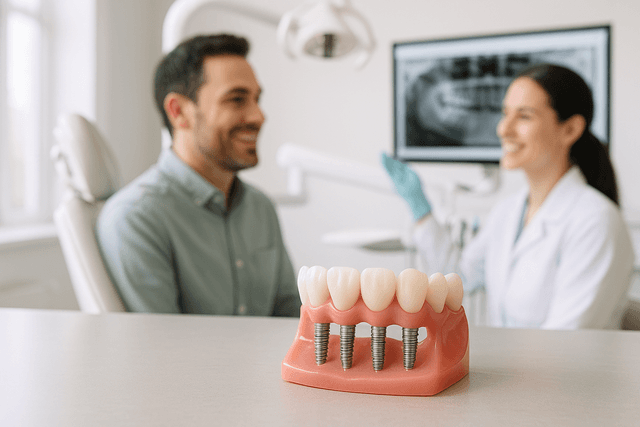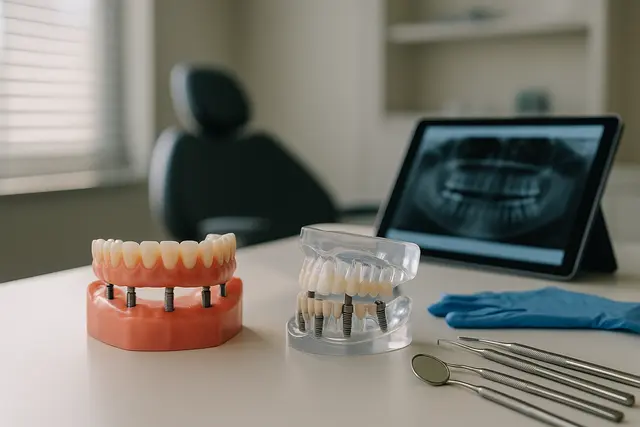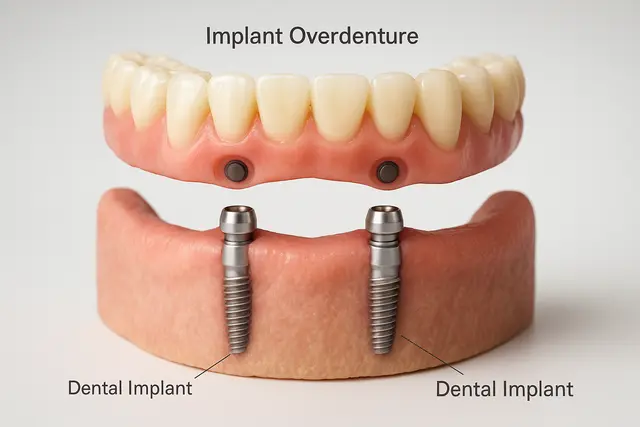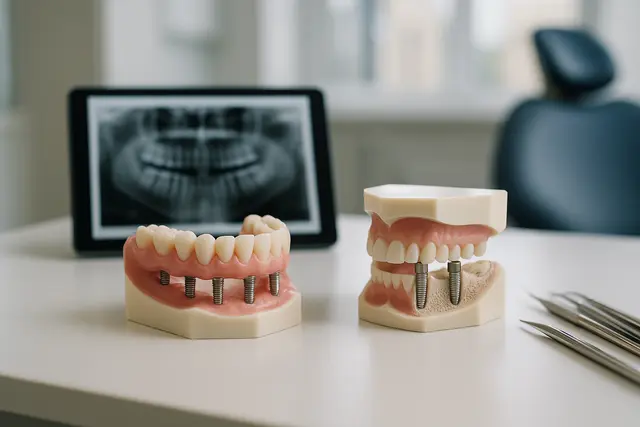Prosthodontics
5 min read
Jul 16, 2025
Implant-Supported Bridge: Procedure, Recovery, and Results
Missing teeth can take a toll on more than just your smile, they can affect how you eat, speak, and feel about yourself. While traditional solutions have their place, modern dentistry now offers a smarter, sturdier alternative that looks and feels like the real deal: the implant-supported bridge.

If you’ve ever had to smile a little smaller because of a gap in your teeth, you’re not alone. Losing a tooth, or several, can be frustrating, not just for your smile, but for your confidence, chewing ability, and overall dental health. Luckily, today’s dentistry offers something better than just a quick fix. Meet the implant-supported bridge: the no-wobble, natural-looking, long-lasting tooth replacement option that actually gives you your bite, and your smile, back.
Let’s walk through how an implant-supported bridge works, what to expect from the procedure, and what your new teeth can do for your everyday life.
How a Bridge Solves the Gap Problem
At its core, a bridge is just what it sounds like. It "bridges" the space left by one or more missing teeth. But not all bridges are built the same. A traditional bridge relies on the teeth on each side of the gap, called abutment teeth, for support. That means grinding down perfectly healthy teeth just to hold up a new one. Traditional bridges require those neighboring teeth to carry the load, which isn't always ideal for your oral health.
With an implant-supported bridge, the support doesn’t come from other teeth. It comes from dental implants, which are small titanium posts placed directly into your jawbone. These act as artificial tooth roots, giving the bridge stability and strength, like natural teeth. That means no pressure on your existing teeth, no slipping around, and no compromising the structure of your smile.
Why a Dental Implant Changes Everything
Dental implants have been a game changer in modern dentistry. Once placed into the jawbone, they fuse with the bone (a process called osseointegration), creating a rock-solid foundation for whatever goes on top, whether it’s a single crown or, in this case, a bridge.
An implant-supported bridge is similar to a traditional one in that it replaces multiple missing teeth in a row, but instead of relying on natural teeth for support, it’s supported by dental implants. That’s a huge plus if your adjacent teeth are healthy and you’d rather not grind them down into pegs for crowns.
The number of implants used depends on how many teeth are missing and where they’re located. Your dentist will evaluate your bone density and the health of your gums to determine the best implant sites. Sometimes, a bone graft is needed before implant placement if there’s been significant bone loss in the area.
Getting an Implant-Supported Bridge: What to Expect
The procedure happens in stages. First comes the implant surgery, where the dental implants are placed into the jawbone. This is typically done under local anesthesia (you’ll be numb but awake), and it's surprisingly easy for most patients. Once the implants are in, healing begins. This can take a few months, giving the implants time to fuse with the jawbone.
During this healing period, you may be given a temporary bridge to help maintain function and appearance. Once everything has healed properly, the abutments (connector pieces) are attached to the implants. These abutments are what your final dental bridge will connect to.
Then comes the fun part: creating your custom bridge. Your dentist will take impressions to ensure the new bridge fits comfortably and looks natural. The final bridge is crafted in a dental laboratory and matched to your existing teeth in shape, size, and color. It should blend in so well that no one will ever know you lost a tooth (or several).
Finally, the bridge is secured in place using dental cement or a screw-retained system. And just like that, your smile is whole again.
Recovery and Life with Your New Smile
Recovery after implant placement is typically smooth. Most people experience mild swelling or soreness, which goes away within a few days. You’ll want to eat soft foods for a bit and follow your dentist’s post-op instructions closely.
Once your implant-supported bridge is placed, the real transformation begins. These bridges aren’t just about looks, they’re fully functional. You can eat, speak, and smile just like you did with your natural teeth. No clicking dentures, no slipping partials, and no awkward gaps.
Care and maintenance are key. Brush and floss daily, clean the bridge and surrounding gum tissue carefully, and don’t skip those regular checkups. With proper care, an implant-supported dental bridge can last many years, often decades.
When to Choose an Implant Bridge Over a Denture
If you’ve lost one tooth or multiple missing teeth in a row, an implant bridge might be your best bet. It provides a fixed solution, unlike a removable partial denture that can shift around or feel bulky. And unlike a traditional dental bridge, you won’t need to file down healthy teeth for support.
Fixed bridges or removable options both exist, but if you’re looking for something that truly feels like your own teeth, firm, natural, and stable, implant-supported restorations win hands-down.
The Bonus Perks You Didn’t Know You Needed
Aside from restoring your smile and chewing power, implant-supported bridges also help prevent bone loss. When you lose a tooth, the jawbone underneath starts to shrink. Dental implants act like tooth roots, keeping the jawbone stimulated and strong.
They also preserve the natural shape of your face, help you avoid that sunken-cheek look that can come with missing teeth, and protect your surrounding teeth from shifting out of place.
And because implant-supported bridges do not require adjacent teeth for support, they help preserve the natural structure of your mouth long-term.
Ready to Restore Your Smile?
If you're dealing with tooth loss, restore your smile with a bridge supported by dental implants. It might be the best move you’ll ever make for your oral health, and your confidence. They look natural, feel secure, and with proper care, they’re a long-lasting tooth replacement option you can count on.
Whether you’re deciding between a fixed implant bridge, a partial denture, or a traditional dental bridge, our team is here to help. We’ll walk you through your options, discuss the type of bridge that fits your needs, and make sure your final dental bridge is crafted with precision and care.
Schedule a consultation. Because life’s too short to cover your smile. Let’s make those teeth and gums happy again.
What Is an Implant-Supported Bridge and How Does It Work?
An implant-supported bridge replaces multiple missing teeth using dental implants instead of relying on adjacent natural teeth for support. Titanium posts are placed into the jawbone to act as artificial roots, and a custom-made bridge is attached to these implants for a stable, natural-looking solution that restores both function and appearance.
How Is an Implant Bridge Different from a Traditional Bridge?
A traditional dental bridge is supported by neighboring teeth, which must be filed down to hold the bridge. In contrast, an implant-supported bridge is anchored by dental implants placed in the jawbone, preserving healthy teeth and offering greater stability, comfort, and longevity.
What Can I Expect During the Implant Bridge Procedure?
The process involves placing dental implants in the jawbone, allowing time for them to heal and fuse with the bone, and then attaching a custom-made bridge. You may wear a temporary bridge during healing. Once complete, your implant bridge looks and functions like natural teeth.
How Long Do Implant-Supported Bridges Last?
With proper care, daily brushing, flossing, and regular dental visits, implant-supported bridges can last many years, often decades. Their durability and bone-stimulating properties make them a long-term solution for missing teeth.
Read Next
Related Posts

Prosthodontics
Implant Supported Dentures Overview
Missing teeth can impact more than just your smile, they can affect your confidence, comfort, and even your diet. Fortunately, modern dentistry offers a solution that’s both secure and natural-looking: implant-supported dentures. This innovative approach blends the stability of implants with the convenience of dentures to create a long-lasting, life-improving upgrade.
5 min read
Oct 29, 2025

Prosthodontics
Implant Overdentures Explained: The Hybrid Solution to Missing Teeth
Missing teeth can impact everything from your ability to eat to your self-confidence. While traditional dentures have long been a go-to solution, they often fall short in comfort and stability. Implant overdentures offer a modern alternative that combines the security of dental implants with the convenience of removable dentures, a true upgrade for those looking to reclaim their smile.
6 min read
Oct 29, 2025

Prosthodontics
Implant Retained Dentures Explained
Considering implant-retained dentures? You're not alone. As modern dentistry evolves, more people are turning to this secure, natural-feeling alternative to traditional dentures. This guide will walk you through what they are, how they work, and why they might be the solution you've been looking for.
4 min read
Oct 28, 2025
Don’t have time to research every dentist around you?
See why 30k+ patients trusted us